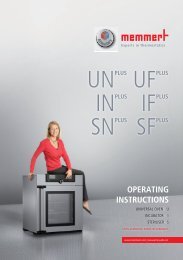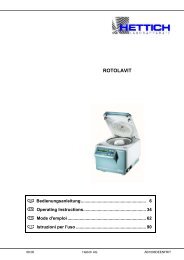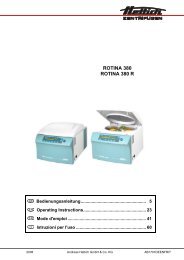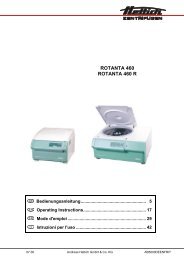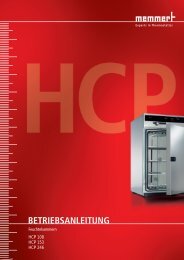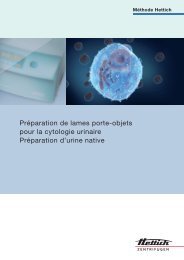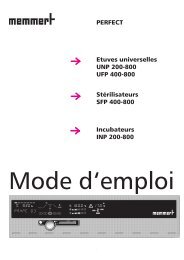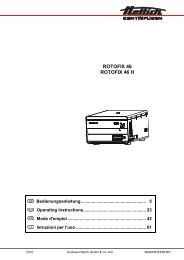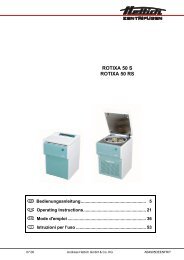MIKRO 200 MIKRO 200 R - Hettich AG, CH
MIKRO 200 MIKRO 200 R - Hettich AG, CH
MIKRO 200 MIKRO 200 R - Hettich AG, CH
You also want an ePaper? Increase the reach of your titles
YUMPU automatically turns print PDFs into web optimized ePapers that Google loves.
EN<br />
20 Relative centrifugal force (RCF)<br />
The relative centrifugal force (RCF) is given as a multiple of the acceleration of gravity (g). It is a unit-free value and<br />
serves to compare the separation and sedimentation performance.<br />
These values are calculated using the formula below:<br />
2<br />
⎛ RPM ⎞<br />
RCF<br />
RCF = ⎜ ⎟ × r × 1,118 ⇒ RPM =<br />
× 1000<br />
1000 ⎠ r × 1,118<br />
⎝<br />
RCF = relative centrifugal force<br />
RPM = rotational speed (revolutions per minute)<br />
r = centrifugal radius in mm = distance from the centre of the turning axis to the bottom of the centrifuge.<br />
For more on the centrifugal radius see the chapter ” Anhang/Appendix,<br />
Rotoren und Zubehör/Rotors and accessories”.<br />
The relative centrifugal force (RCF) stands in relation to the revolutions per minute and the centrifugal<br />
radius.<br />
21 Centrifugation of materials with higher density<br />
The rotors are designed to centrifuge substances up to a maximum mean homogenous density of 1.2 kg/dm 3 when<br />
rotating at the stated speed.<br />
Denser substances must be centrifuged at lower speed.<br />
The permissible speed can be calculated using the following formula:<br />
Reduced speed (nred)<br />
=<br />
1.2<br />
Greater density<br />
x Rated speed<br />
e.g.: RPM 4000, density 1.6 kg/dm 3<br />
1.2<br />
nred = x 4000 = 3464 RPM<br />
1.6<br />
If in doubt you should obtain clarification from the manufacturer.<br />
22 Emergency release<br />
In the event of a power failure the lid cannot be opened by motor. An emergency release has to be executed by<br />
hand.<br />
For emergency release disconnect the centrifuge from the mains.<br />
Open the lid only during rotor standstill.<br />
See figure on page 2.<br />
• Switch off the mains switch (switch position "0").<br />
• Look through the window in the lid to be sure that the rotor has come to a standstill.<br />
• Insert the hexagonal wrench key into the bore hole (Fig. 1, A) and carefully rotate by half a turn in clockwise<br />
direction until the lid can be opened.<br />
• Pull the hexagon socket head wrench out of the drilling again.<br />
• After turning the centrifuge on again, press the button STOP / OPEN so that the motor-driven lid locking once<br />
again assumes the normal position (opened).<br />
23 Maintenance and servicing<br />
Pull the mains plug before cleaning.<br />
Before any other cleaning or decontamination process other than that recommended by the manufacturer is<br />
applied, the user has to check with the manufacturer that the planned process does not damage the device.<br />
• Cleaning agents and disinfectants which lie in the pH range 5 – 8 are to be utilised. Alkaline cleaning agents with<br />
a pH value > 8 are to be avoided.<br />
• In order to prevent appearances of corrosion through cleaning agents or disinfectants, the application guide from<br />
the manufacturer of the cleaning agent or disinfectant are absolutely to be heeded.<br />
29/64



